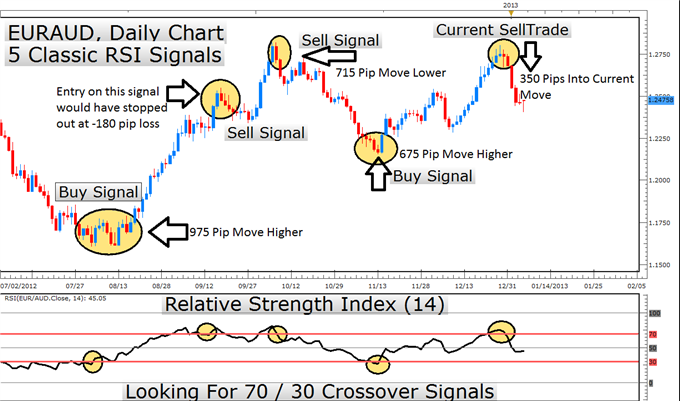Article Summary: Too many traders define all losing trades as a mistake when in reality a mistake should only be something that you can control. By taming trade size and knowing when a mistake has truly been made, you can correct your real trading mistakes and keep yourself moving toward reaching your goals.
Analyzing and trading a seemingly chaotic market seems easy in hindsight yet can be frustrating in real time. Many new traders set out to build or improve their strategy with a defined market to trade and a set of trading rules to follow. However, if after 10 live trades are placed and 6 turn out losers, new traders often believe they’ve made 6 mistakes when most likely they have not.
Learn Forex: Multiple Entry Signals Based on Classic RSI Signals

As an example, the chart above will show you that there were plenty of good entries that played out to the traders benefit, but in real-time these were simply higher probability trades based on prior price action. You’ll also notice a trade that did not work out well. This does not mean that a mistake was made but rather that the market didn’t play out in the way the trader expected.
So, What Constitutes A Trading Mistake?
One thing that can greatly assist new traders is to focus on the rules of their trading system and to define breaking those rules as the only mistake you can make in the markets. Whether those rules are simple or complex, sticking to your trading rules can help create your edge in a market where no one knows exactly what the closing price will be for the day.
Why is this approach one we recommend you take? First, few things can be as frustrating as trying to rest your success or failure solely on the outcome which you cannot control. In other words, your behavior is something you can control so that is where you should limit the responsibility.
Another way to look at this new thought is that if you’re trading without rules, every trade is a mistake or a deliberate action littered with mistakes. If you find yourself in a profitable trade, you’ll have a hard time repeating the success because you won’t have the rules to follow the next time a similar set up appears.
Understand that market behavior is something that you can take advantage of through technical or fundamental analysis but you cannot control. Naturally, there are behaviors for you to follow that can and should make up a list of rules that will help minimize the pain felt should the market go against you. Ultimately though, you should train yourself to only see failure only as not following your rules as opposed to the outcome of individual trades.
What Should Go Into Your Trading Rules?
Trading rules can and should be as individualistic as your finger print. Because there are multiple market environments to trade it can be helpful to have specific behavioral rules for different market patterns. The market environments that your rules should focus on are trending (up and / or down) and ranging markets.
Your ultimate goal here is to have rules for every style of market you will face and trade. The reason for having rules for different market types is because a major source of frustration for newer traders is trying to adapt to a trend following methodology in a ranging market or vice-versa. It is extremely difficult and not necessary to keep one set of rules for all market conditions because different markets require different rules.
Learn Forex: Having Trading Rules for Different Market Types Can Help Avoid Frustration

In addition to having separate objectives and rules for individual market environments it can be of vital importance to have rules regarding trade size. Of all the mistakes, which we now recommend has nothing to do with the profit or loss on the trade but your ability to stick to your rules, improper trade size is the first mistake you should set out to fix. One of the easiest ways to make sure you stick to your rules regarding trade size is to have a calculator or app that takes inputs regarding percentage of your account that you’re willing to risk along with stop and limits that you’re comfortable with based on the market environment.
Other rules you can focus on can be what time of day you will trade, how you will trade during active and quiet hours, and how much capital you should trade with. In the end, you should schedule time to look over your rules to see if you should take away or add to your rules to better suit the current market environment. By monitoring your progress and minimizing your mistakes, you’ll build momentum and accountability toward reaching your goals.
Happy Trading!
---Written by Tyler Yell, Trading Instructor
To be added to Tyler’s e-mail distribution list, please click here.
Unsure which indicators match up with your skill set?
Take our Forex Trader IQ Course to receive a custom learning path for how to trade FX.




